Consumer Panic Buying: Realizing Its Consequences and Repercussions on the Supply Chain
Abstract
1. Introduction
2. Literature Review
2.1. Consumer Panic Buying
2.2. Supply Chain Management
3. Methodology
3.1. Supply Chain Model
3.2. Consumer Model
3.3. Simulation Design
4. Results and Analysis
4.1. Validation
4.2. Effect of Strategy on Consumer Satisfaction
4.3. Effect on Supply Chain Performance
4.3.1. Inventory-Sale Ratio
4.3.2. Stockoutness
4.4. Effect of Time Variation of the Strategy Initialization
4.5. Effect of Variation of Stores with Strategy
4.6. Effect of Variation in the Amount of Reports and Rumors
4.7. Effect of Variation in the Number of Panic Buyers
5. Discussion
6. Conclusions
Author Contributions
Funding
Institutional Review Board Statement
Informed Consent Statement
Data Availability Statement
Conflicts of Interest
References
- Fang, Y.; Shou, B. Managing supply uncertainty under supply chain cournot competition. Eur. J. Oper. Res. 2015, 243, 156–176. [Google Scholar] [CrossRef]
- Kumar, M.; Basu, P.; Avittathur, B. Pricing and sourcing strategies for competing retailers in supply chains under disruption risk. Eur. J. Oper. Res. 2018, 265, 533–543. [Google Scholar] [CrossRef]
- Shou, B.; Xiong, H.; Shen, X. Consumer Panic Buying and Quota Policy under Supply Disruptions. Working Paper; City University of Hong Kong: Hong Kong, China, 2016. [Google Scholar]
- Ballantine, P.W. Changes in retail shopping behaviour in the aftermath of an earthquake. Int. Rev. Retail Distrib. Consum. Res. 2013, 1, 28–42. [Google Scholar] [CrossRef]
- Strahle, W.M.; Bonfield, E.H. Understanding consumer panic: A sociological perspective. Adv. Consum. Res. 1989, 16, 567–573. [Google Scholar]
- Yuen, K.F.; Wang, X.; Ma, F.; Li, K.V. The psychological causes of panic buying following a health crisis. Int. J. Environ. Res. Public Health 2020, 14, 3513. [Google Scholar] [CrossRef] [PubMed]
- Wilkens, J.; The San Diego Union-Tribune. Why We Hoard: Fear at Root of Panic-Buying, Psychologists Say. Available online: https://www.sandiegouniontribune.com/news/health/story/2020-03-22/hoard-fear-panic-buying-psychology (accessed on 16 December 2020).
- Loxton, M.; Truskett, R.; Scarf, B.; Sindone, L.; Baldry, G.; Zhao, Y. Consumer behaviour during crises: Preliminary research on how coronavirus has manifested consumer panic buying, herd mentality, changing discretionary spending and the role of the media in influencing behaviour. J. Risk Financ. Manag. 2020, 13, 166. [Google Scholar] [CrossRef]
- Mussell, A.; Bilyea, T.; Hedley, D. Agrifood supply chains and covid19: Balancing resilience and vulnerability. Agri Food Econ. Syst. 2020, 1–6. Available online: http://www.agrifoodecon.ca/uploads/userfiles/files/agri-food%20supply%20chains%20and%20covid-19%20mar%2022-20(1).pdf (accessed on 16 December 2020).
- Yoon, J.; Narasimhan, R.; Kim, M. Retailers sourcing strategy under consumer stockpiling in anticipation of supply disruptions. Int. J. Prod. Res. 2018, 56, 3615–3635. [Google Scholar] [CrossRef]
- Dulam, R.; Furuta, K.; Kanno, T. Development of an agent-based model for the analysis of the effect consumer panic buying on supply chain disruption due to a disaster. J. Adv. Simul. Sci. Eng. 2020, 7, 102–116. [Google Scholar] [CrossRef]
- Dulam, R.; Furuta, K.; Kanno, T. Quantitative Decision-making Model for Consumer Panic Buying in Disaster Scenarios. In Proceedings of the 30th European Safety and Reliability Conference and 15th Probabilistic Safety Assessment and Management Conference, Venice, Italy, 1–5 November 2020. [Google Scholar]
- Liren, X.; Junmei, C.; Mingqin, Z. Research on Panic Purchase’s Behavior Mechanism. In Proceedings of the 9th International Conference on Innovation and Management, Eindhoven, The Netherlands, 14–16 November; 2012; pp. 1332–1335. [Google Scholar]
- Kurihara, A.S.; Maruyama, A. Luloff: Analysis of Consumer Behavior in the Tokyo Metropolitan Area after the Great East Japan Earthquake. J. Food Syst. Res. 2012, 18, 415–426. [Google Scholar] [CrossRef][Green Version]
- Cavallo, A.; Cavallo, E.; Rigobon, R. Prices and supply disruptions during natural disasters. Rev. Income Wealth 2014, 60, S449–S471. [Google Scholar] [CrossRef]
- Forbes, S. Post-disaster consumption: Analysis from the 2011 christchurch earthquake. Int. Rev. Retail Distrib. Consum. Res. 2017, 27, 28–42. [Google Scholar] [CrossRef]
- Lindsay, L.; Hyunju, S. Fear during natural disaster: Its impact on perceptions of shopping convenience and shopping behavior. Serv. Mark. Q. 2018, 39, 1–17. [Google Scholar]
- Keane, M.; Neal, T. Consumer Panic in the COVID-19 Pandemic. J. Econom. 2020, 220, 86–105. [Google Scholar] [CrossRef] [PubMed]
- Prentice, C.; Chen, J.; Stantic, B. Timed intervention in covid-19 and panic buying. J. Retail. Consum. Serv. 2020, 57, 102203. [Google Scholar] [CrossRef]
- Bernstein, P.L. Against the Gods: The Remarkable Story of Risk; John Wiley and Sons. INC: New York, NY, USA, 1996. [Google Scholar]
- Christopher, M.; Peck, H. Building the Resilient Supply Chain. Int. J. Logist. Manag. 2004, 15, 1–13. [Google Scholar] [CrossRef]
- Katsaliaki, K.; Galetsi, P.; Kumar, S. Supply chain disruptions and resilience: A major review and future research agenda. Ann. Oper. Res. 2021, 1–38. [Google Scholar] [CrossRef]
- Mensah, P.; Merkuryev, Y. Developing a Resilient Supply Chain. Procedia Soc. Behav. Sci. 2014, 110, 309–319. [Google Scholar] [CrossRef]
- Ivanov, D.; Wendler, E. Natural Disasters and Supply Chain Disruption Management. Handbook of Disaster Risk Reduction and Management; World Scientific: New York, NY, USA, 2017; Available online: https://www.worldscientific.com/doi/10.1142/9789813207950_0010 (accessed on 16 December 2020).
- Inoue, H.; Todo, Y. Firm-Level Simulation of Supply Chain Disruption Triggered by Actual and Predicted Earthquakes. SSRN Electron. J. 2017, 841–847. [Google Scholar] [CrossRef]
- Giannakis, M.; Louis, M. A multi-agent based framework for supply chain risk management. J. Purch. Supply Manag. 2011, 17, 23–31. [Google Scholar] [CrossRef]
- Zheng, R.; Shou, B.; Yang, J. Supply disruption management under consumer panic buying and social learning effects. Omega 2021, 101, 102238. [Google Scholar] [CrossRef]
- Tsao, Y.-C.; Raj, P.V.R.P. Product substitution with customer segmentation under panic buying behavior. Sci. Iran. 2019. [Google Scholar] [CrossRef]
- Hobbs, J.E. Food supply chains during the COVID-19 pandemic. Can. J. Agric. Econ. Can. D’agroeconomie 2020, 68, 171–176. [Google Scholar] [CrossRef]
- MacKenzie, C.A.; Barker, K.; Santos, J.R. Modeling a severe supply chain disruption and post-disaster decision making with application to the Japanese earthquake and tsunami. IIE Trans. 2014, 46, 1243–1260. [Google Scholar] [CrossRef]
- Russell, R.S.; Taylor, B.W. Operations Management, 7th ed.; John Wiley and Sons. INC: Hoboken, NJ, USA, 2011. [Google Scholar]
- Water Intake Calculator. Available online: https://goodcalculators.com/water-intake-calculator/ (accessed on 16 September 2020).
- Yano, K. Water Consumption Survey. 2007. Available online: https://unit.aist.go.jp/riss/crm/exposurefactors/documents/factor/food_intake/intake_water.pdf (accessed on 16 September 2020).
- Japan Today, Panic Buying Leaves Shelves Empty Following 2011 Earthquake. Available online: https://japantoday.com/category/national/panic-buying-leaves-shelves-empty-following-earthquake (accessed on 16 September 2020).
- Hori, M.; Iwamoto, K. The Run on Daily Foods and Goods After the 2011 Tohoku Earthquake. Jpn. Political Econ. 2014, 40, 69–113. [Google Scholar] [CrossRef]
- Statistics of Japan, (Official Statistics of the Japanese Government). Available online: https://www.e-stat.go.jp/stat-search/files?page=1&toukei=00450171&tstat=000001041744 (accessed on 16 September 2020).
- Ministry of Economy, Trade and Industry, Japan. Available online: https://www.meti.go.jp/statistics/tyo/syougyo/result-2/h26/index-gyodata.html (accessed on 20 September 2020).
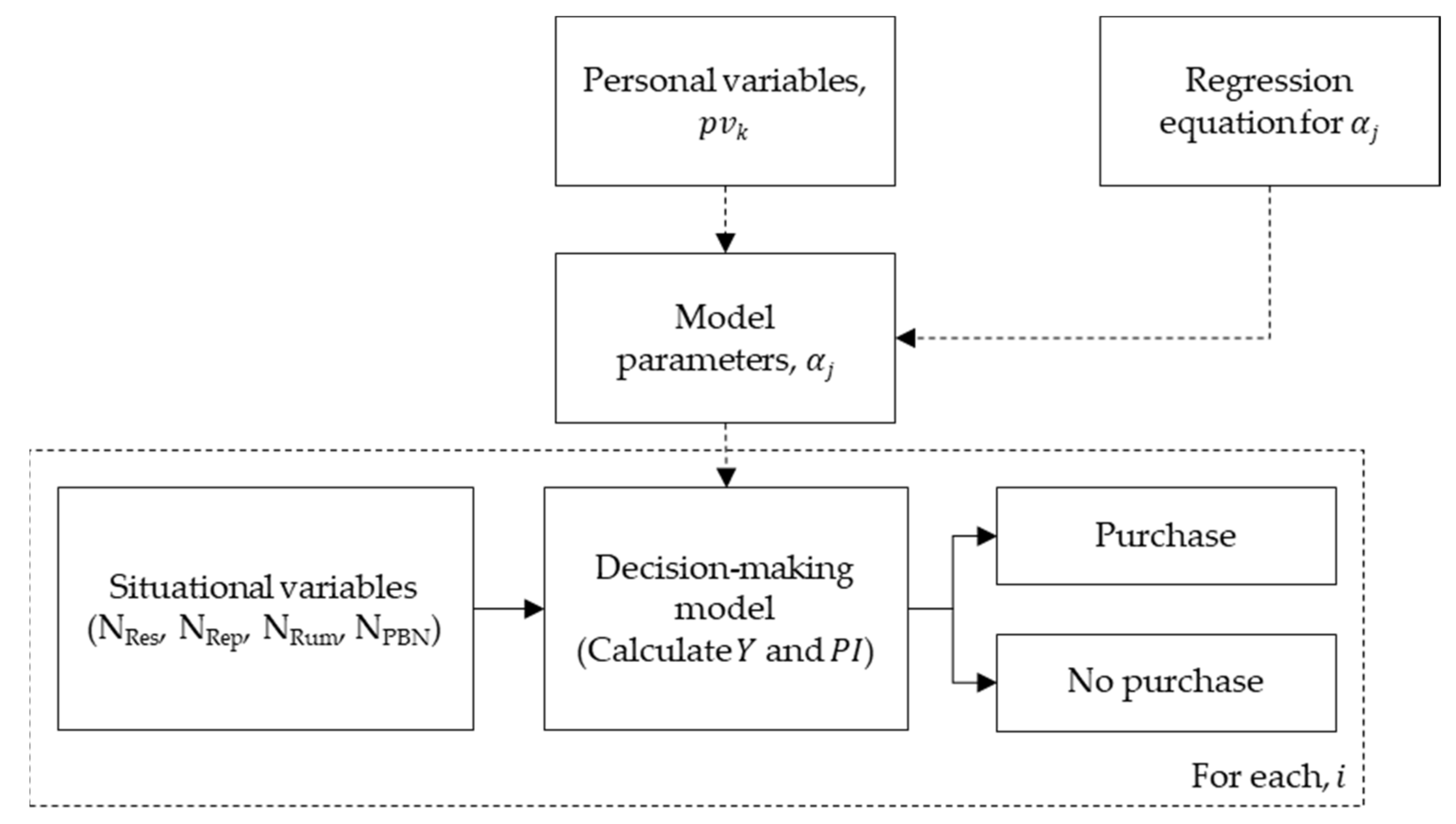

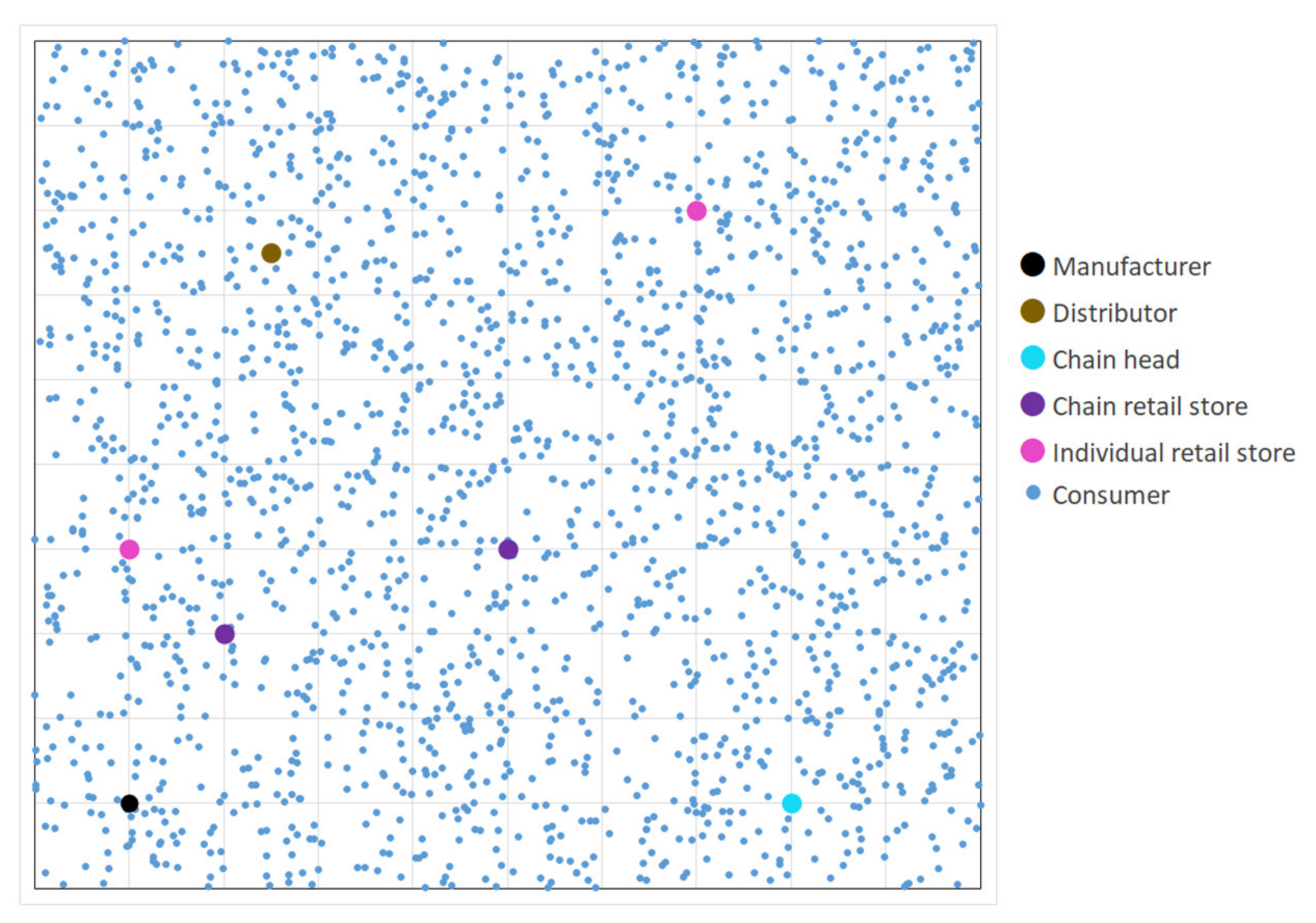

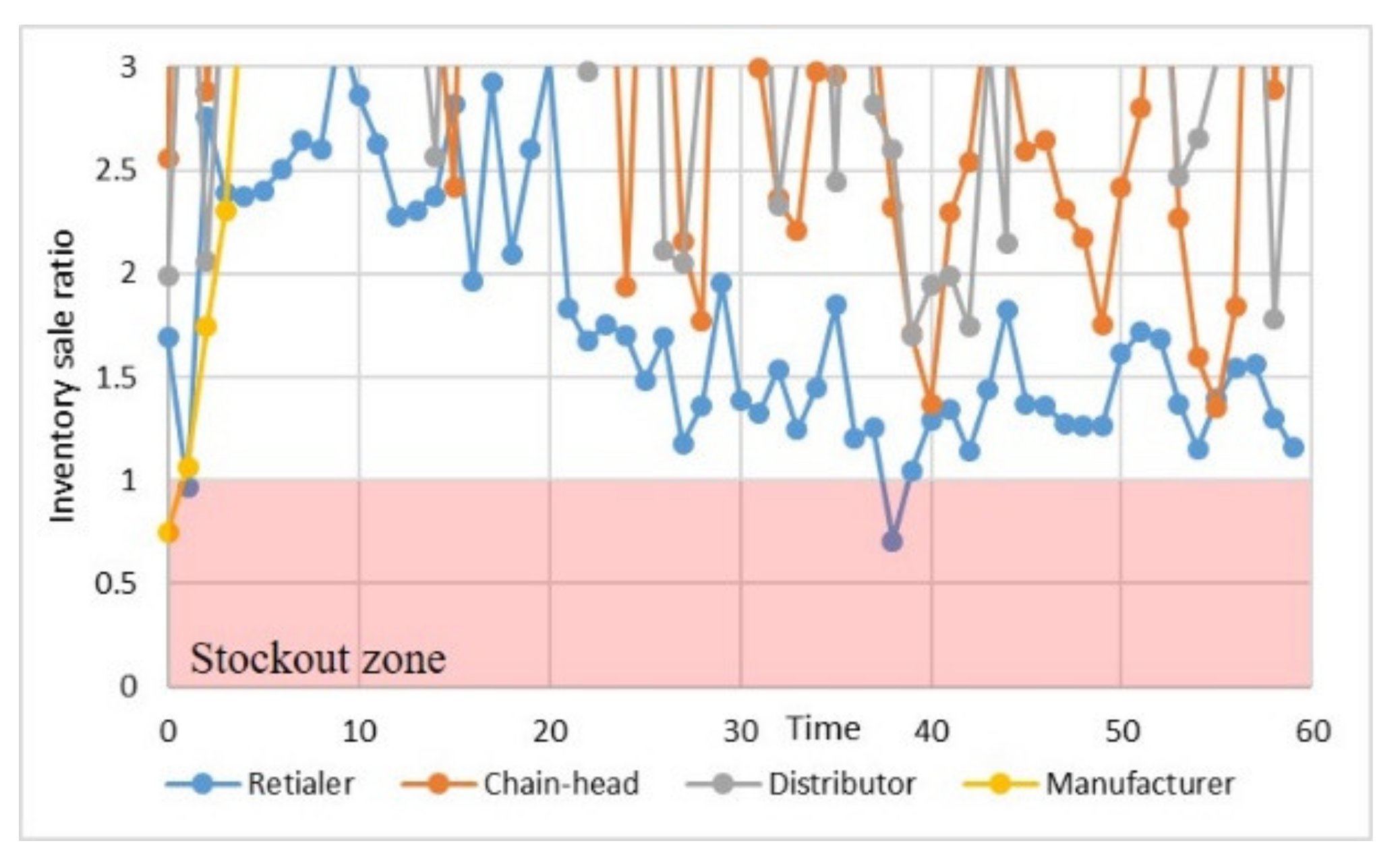

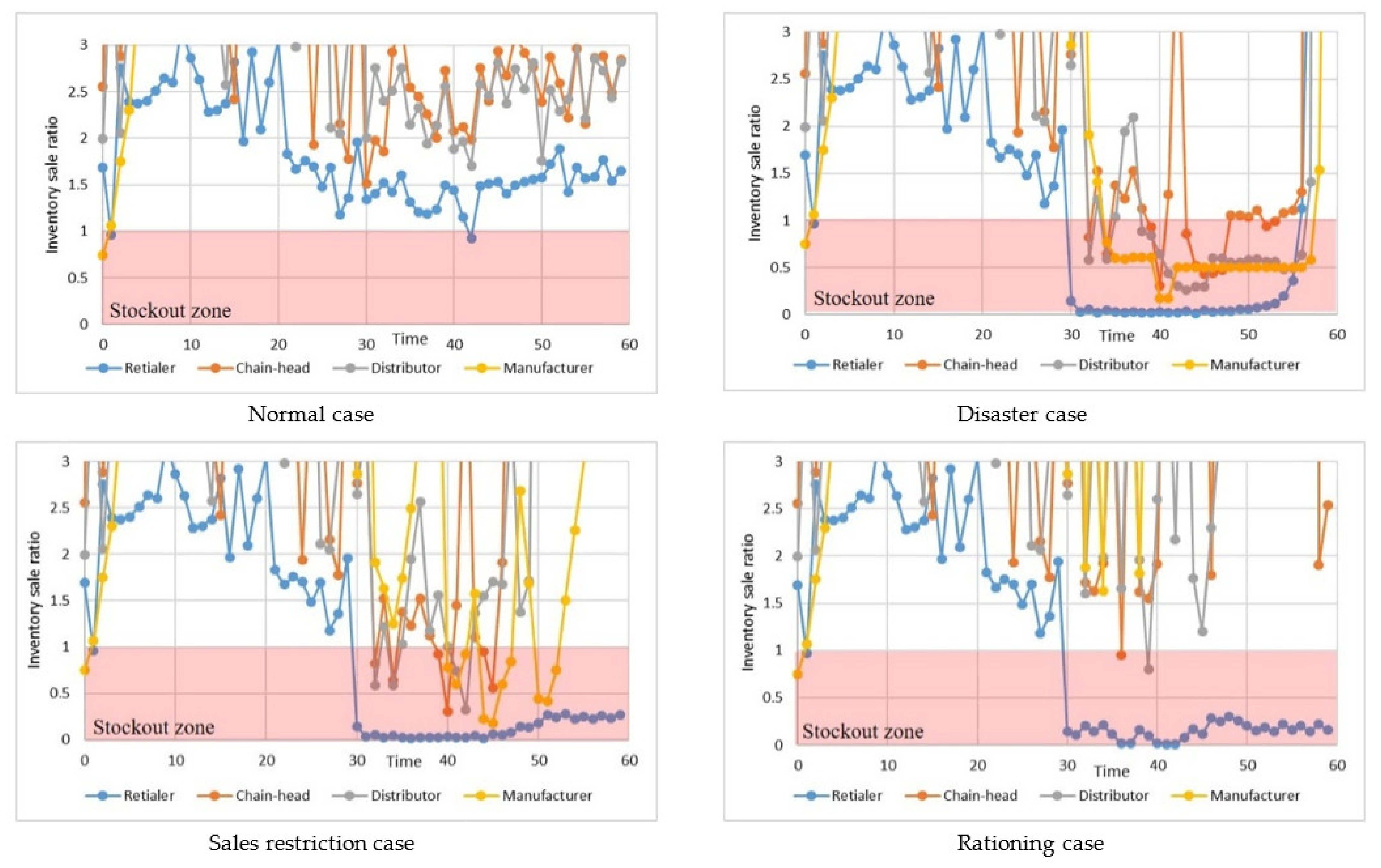

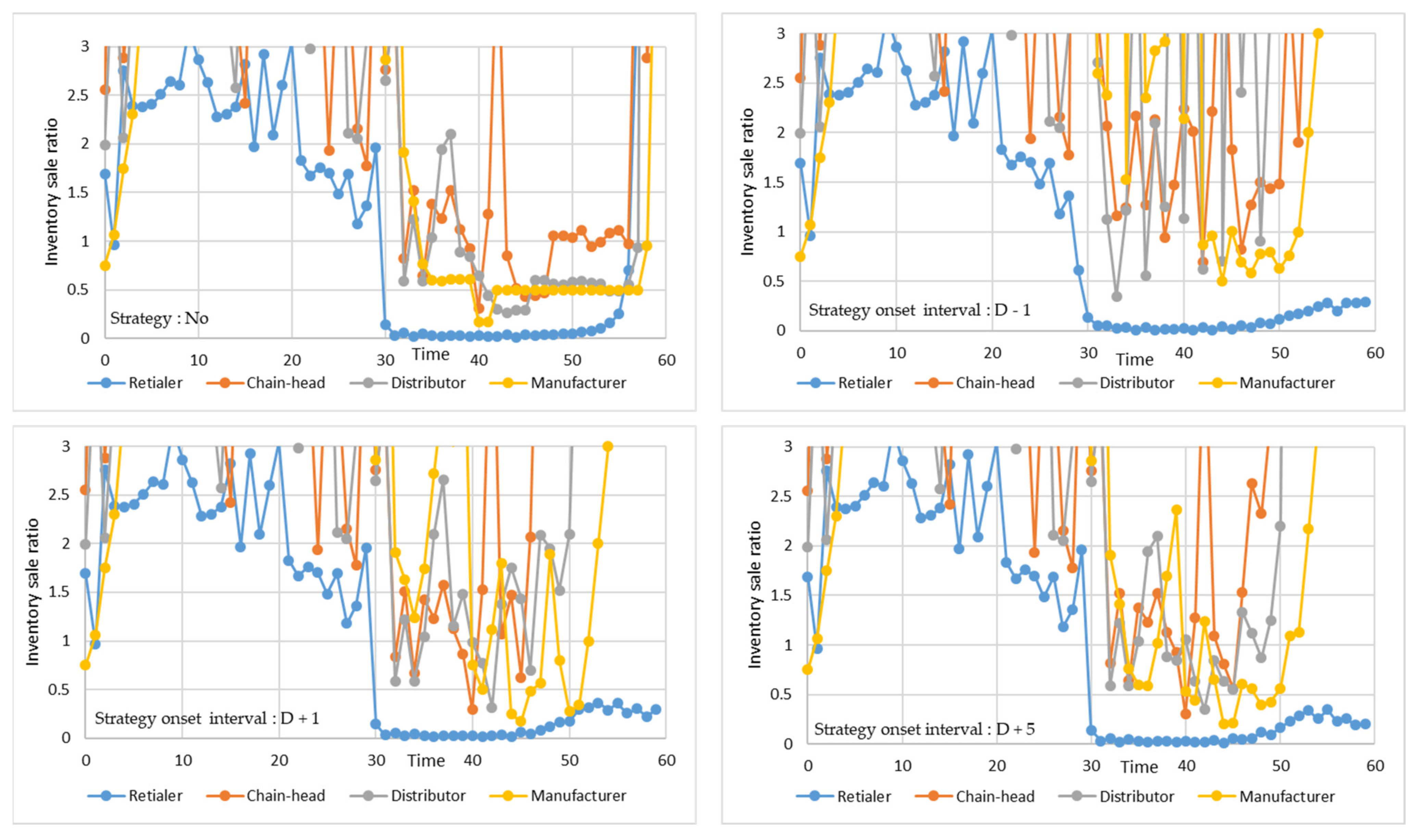
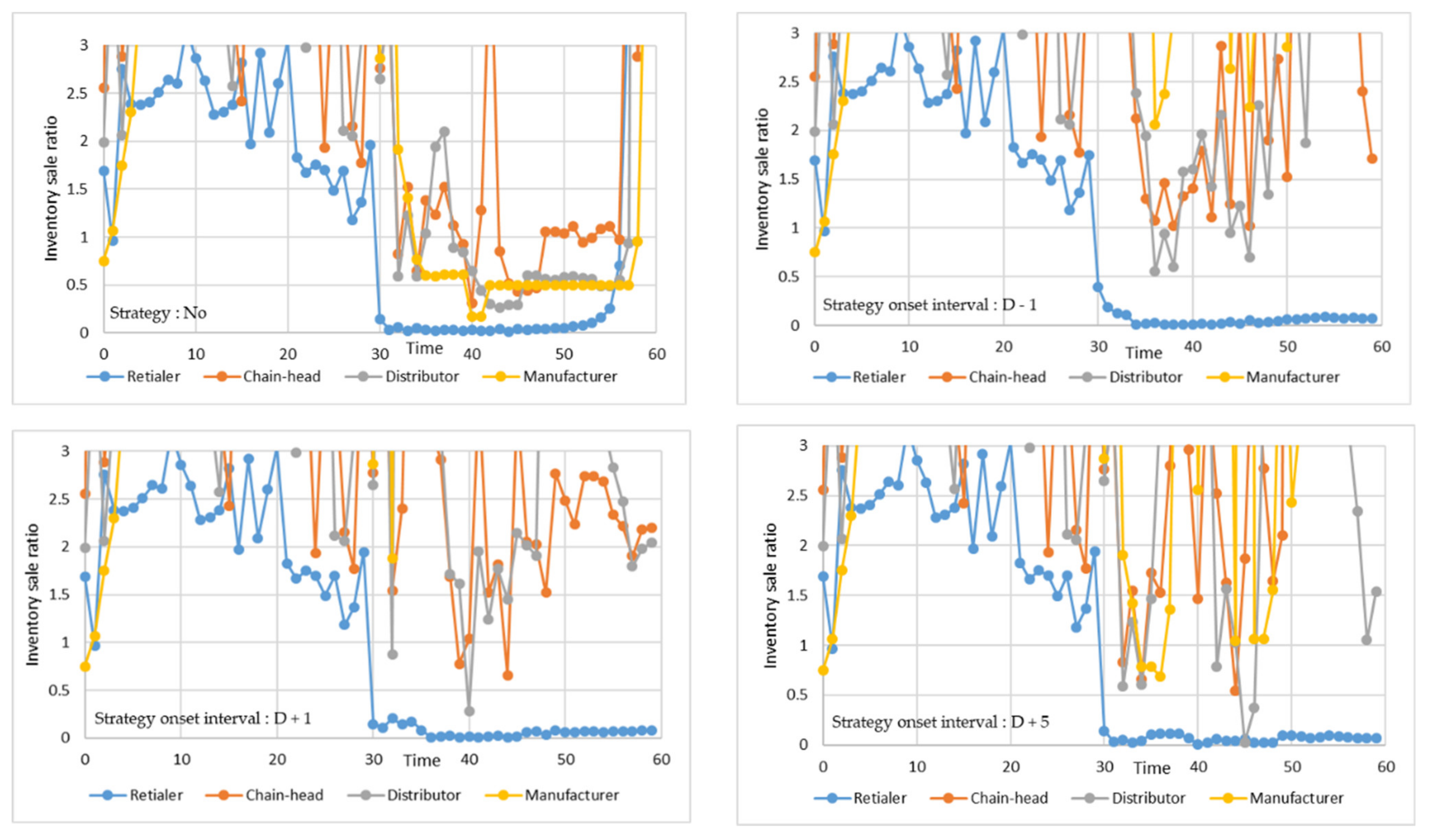
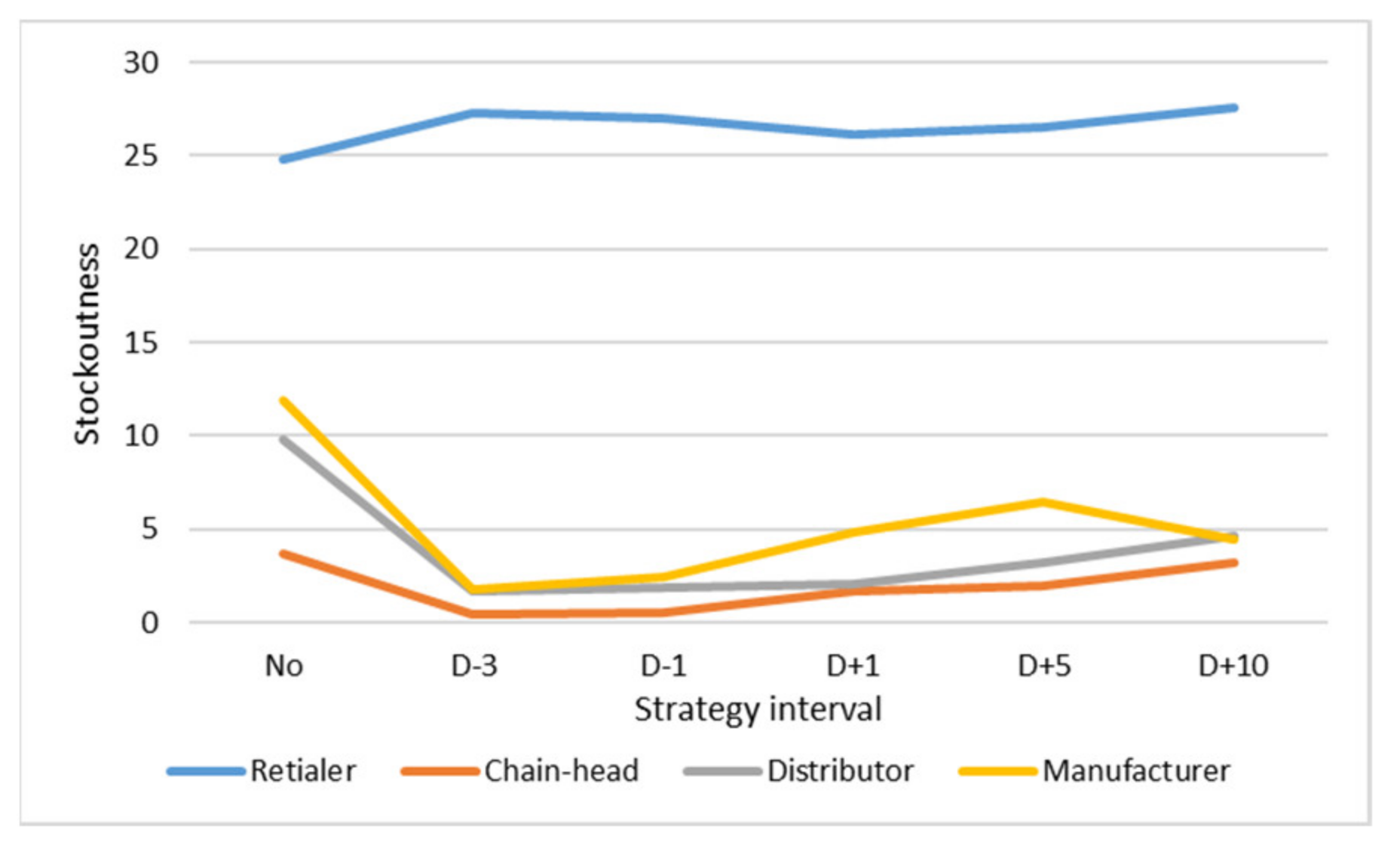
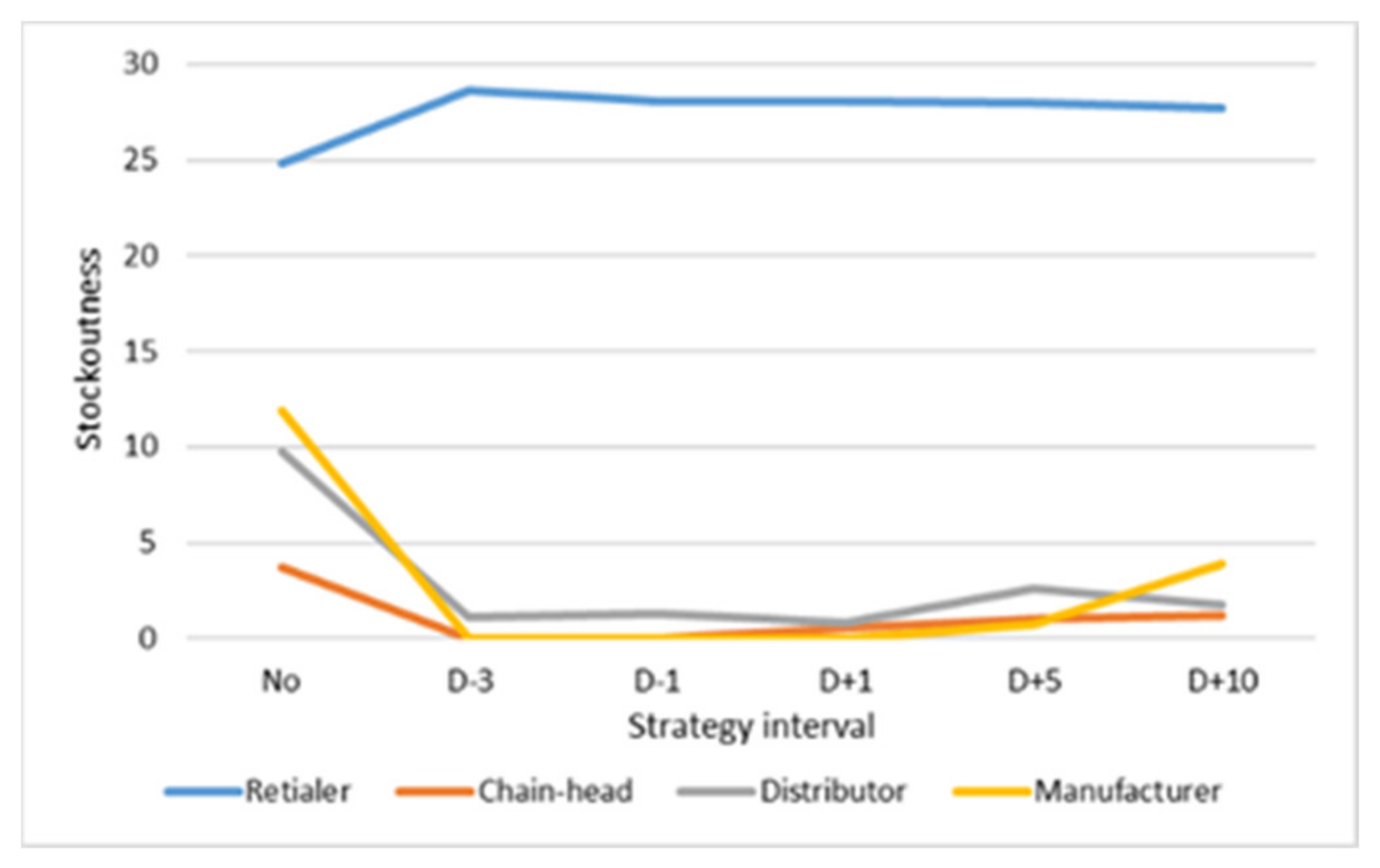
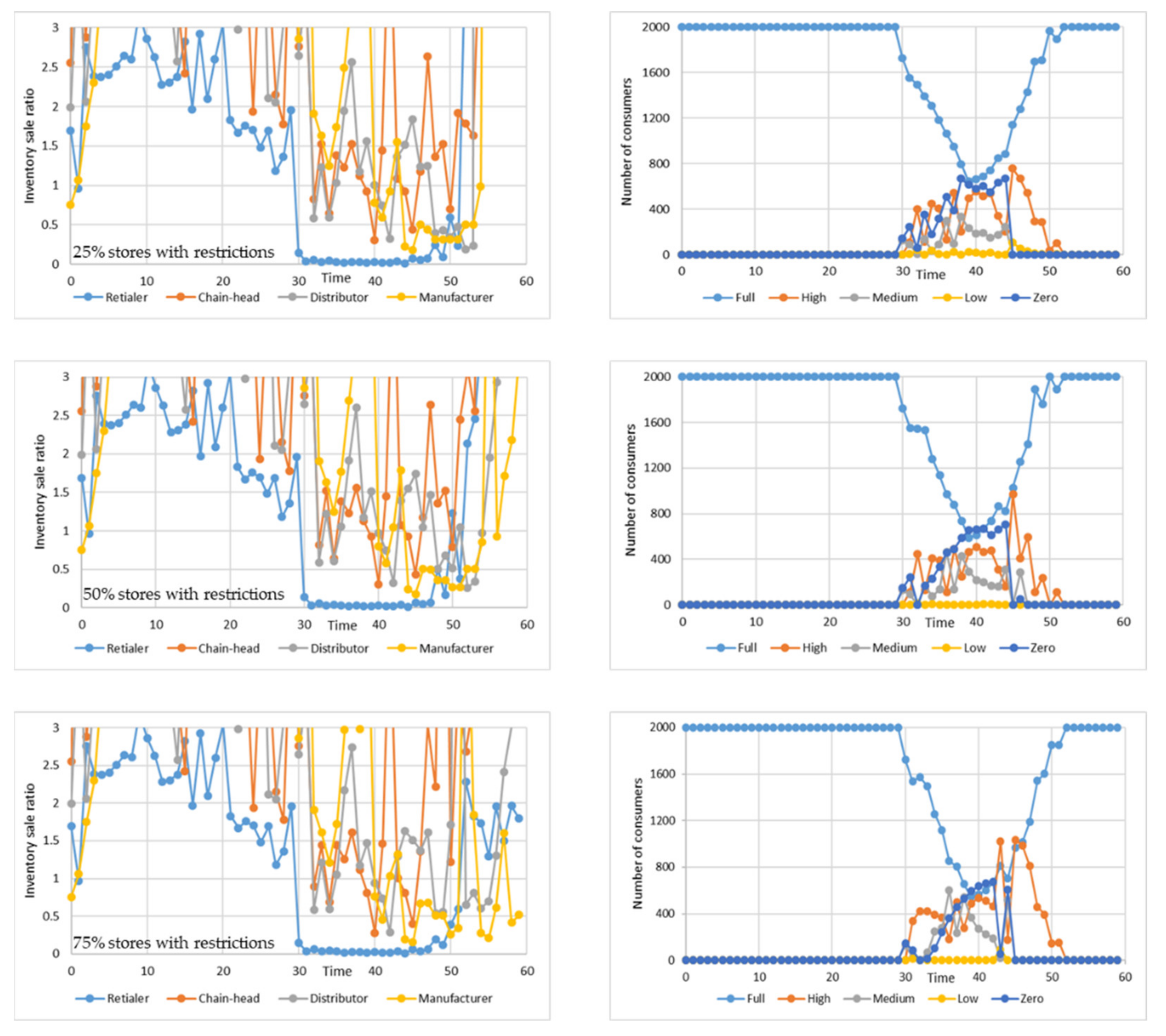

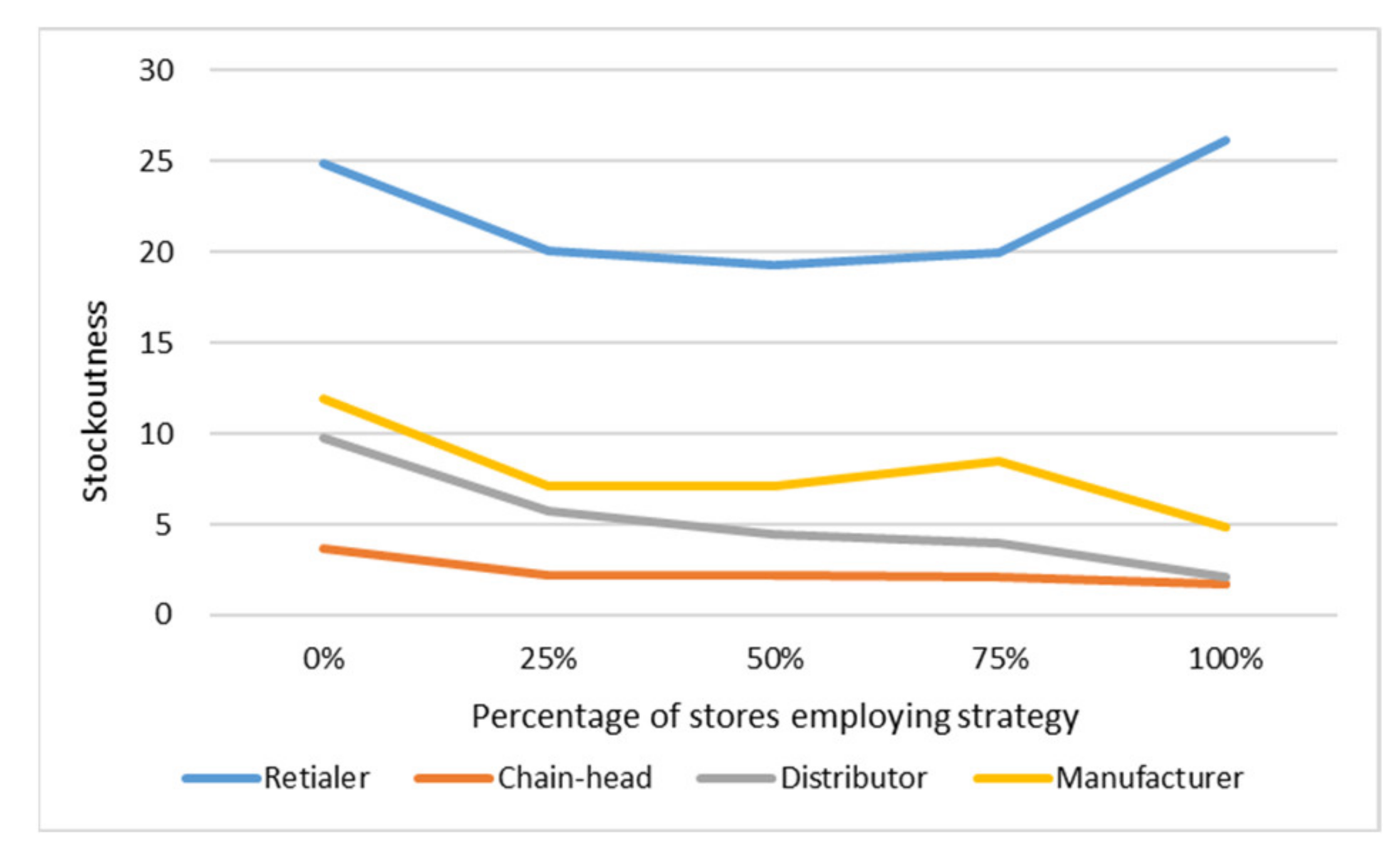
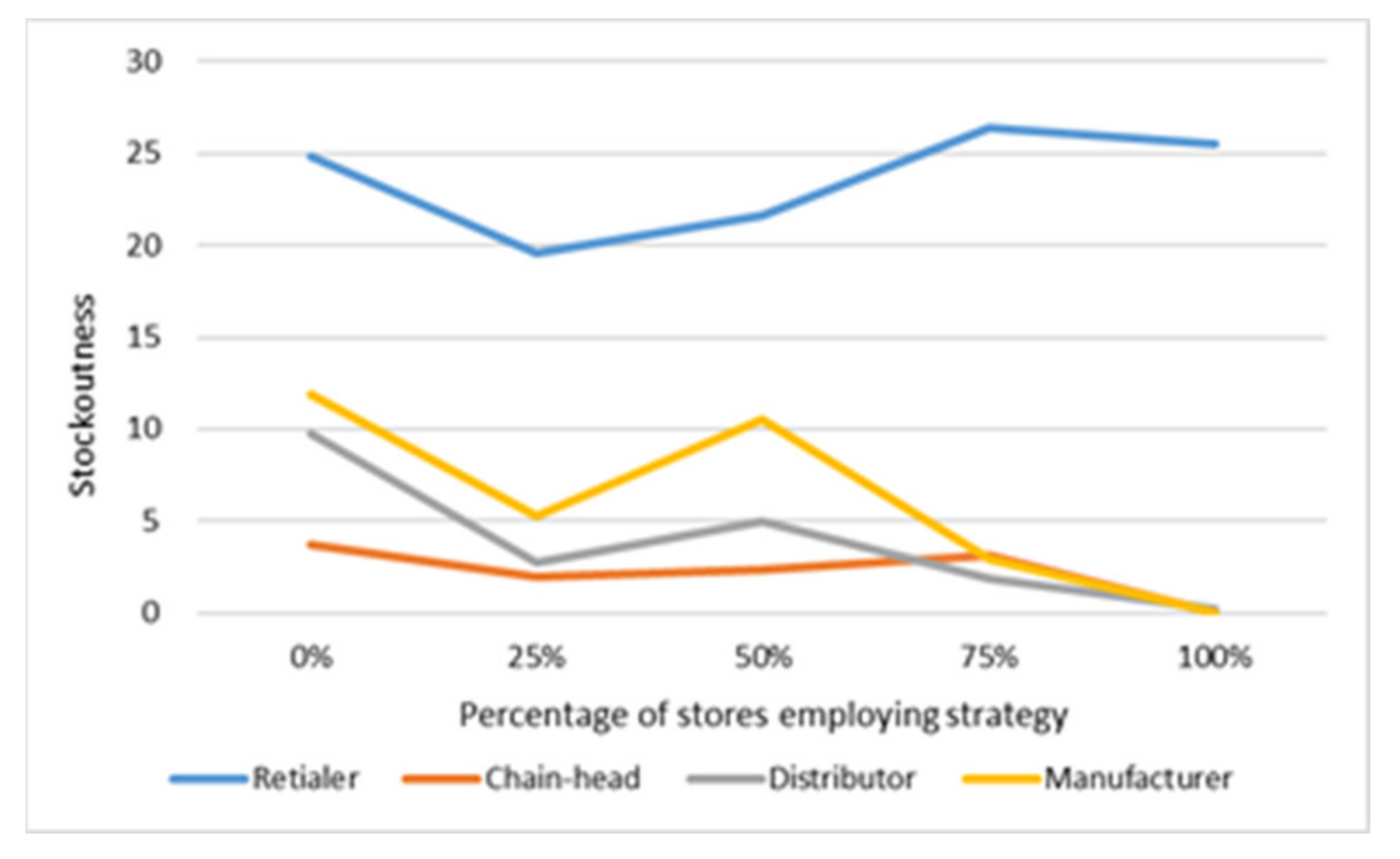

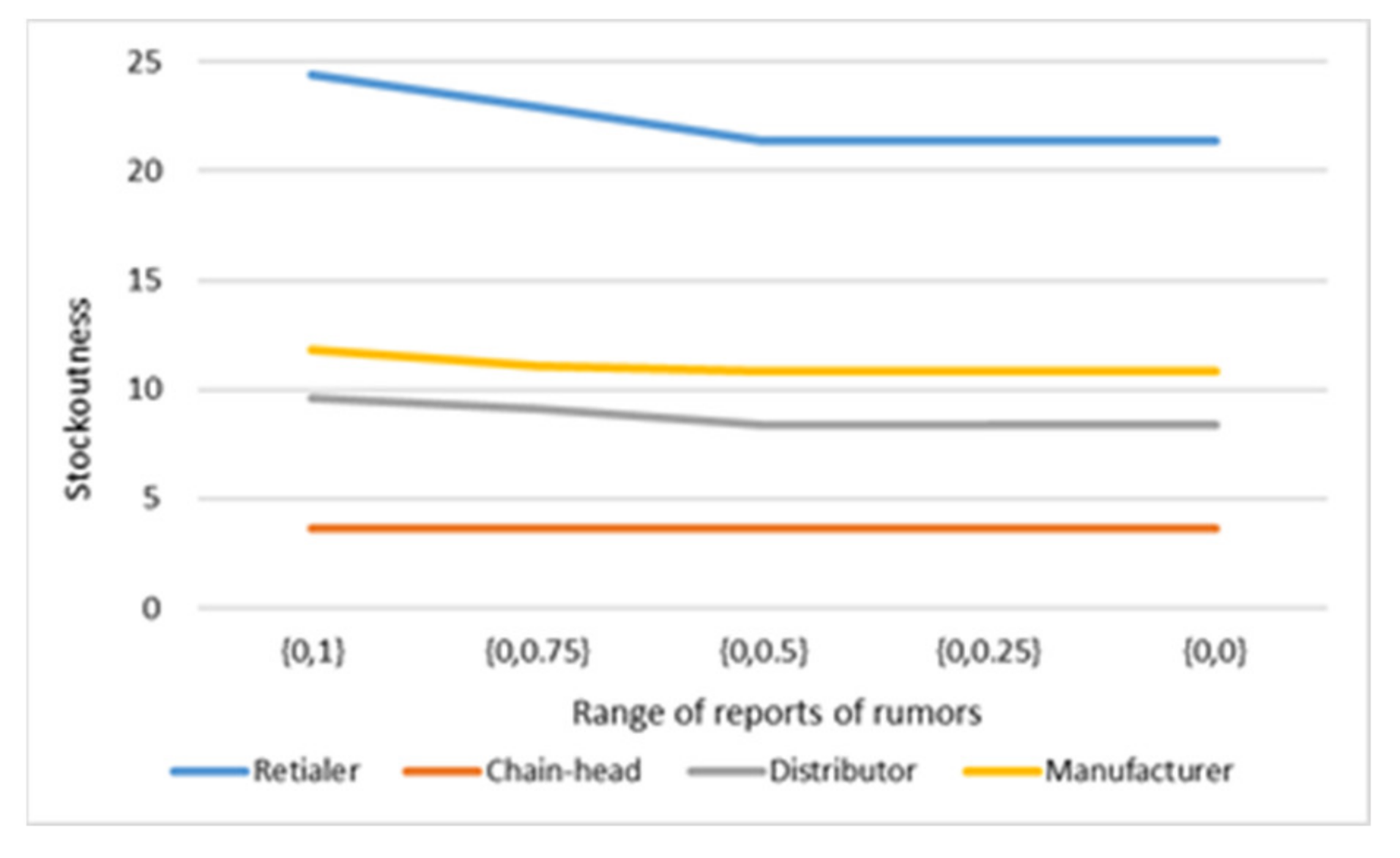
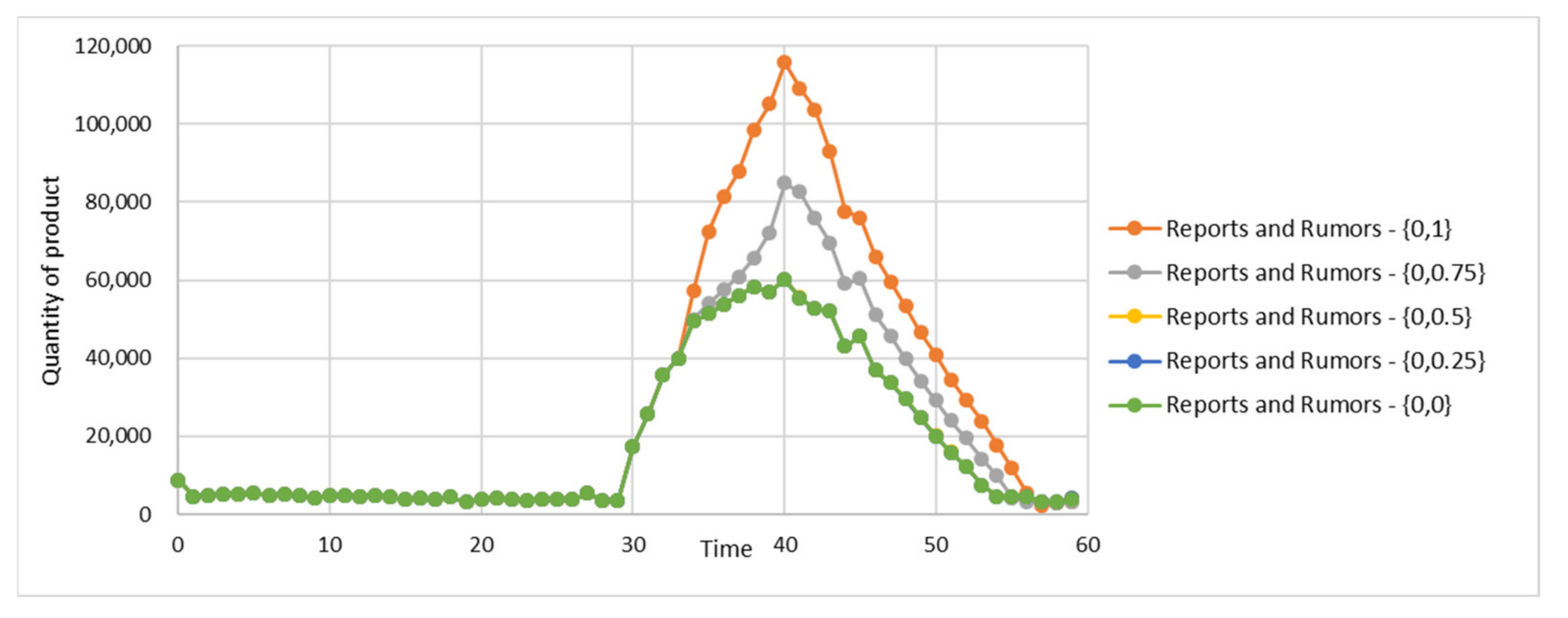
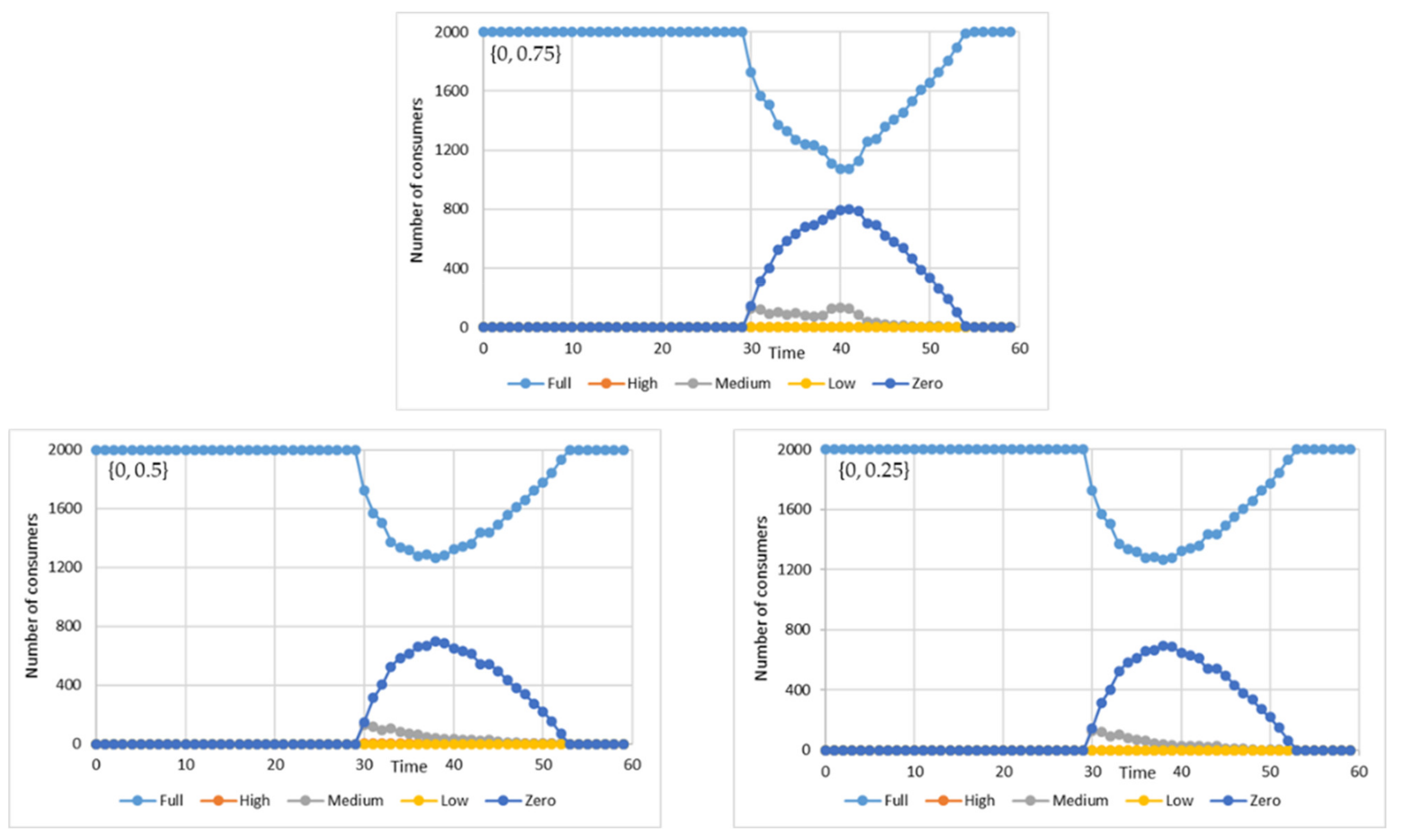



| Explanatory Variables | Response Variables |
|---|---|
| Household size | Effect of sales restrictions |
| Presence of children | Effect of reports |
| Past purchase behavior | Effect of rumors |
| Past stockpiling behavior | Effect of neighbor’s behavior |
| Risk temperament | |
| Anxious temperament |
| Case | R | CH | D | M |
|---|---|---|---|---|
| Normal | 0.07 | 0 | 0 | 0 |
| Disaster | 24.83 | 3.68 | 9.77 | 11.92 |
| Sale restriction | 26.55 | 1.80 | 1.76 | 4.26 |
| Rationing | 25.53 | 0.04 | 0.20 | 0 |
| Strategy Initialization Interval | R | CH | D | M |
|---|---|---|---|---|
| No strategy | 24.83 | 3.68 | 9.77 | 11.92 |
| D − 3 | 27.33 | 0.41 | 1.67 | 1.73 |
| D − 1 | 27.02 | 0.55 | 1.87 | 2.43 |
| D + 1 | 26.11 | 1.72 | 2.06 | 4.85 |
| D + 5 | 26.55 | 1.93 | 3.21 | 6.44 |
| D + 10 | 27.54 | 3.23 | 4.66 | 4.43 |
| Strategy Initialization Interval | R | CH | D | M |
|---|---|---|---|---|
| No strategy | 24.83 | 3.68 | 9.77 | 11.92 |
| D − 3 | 28.68 | 0 | 1.12 | 0 |
| D − 1 | 28.07 | 0 | 1.26 | 0 |
| D + 1 | 28.04 | 0.57 | 0.85 | 0 |
| D + 5 | 28.01 | 0.97 | 2.62 | 0.74 |
| D + 10 | 27.73 | 1.20 | 1.74 | 3.86 |
| Percent of Stores with Restrictions | R | CH | D | M |
|---|---|---|---|---|
| 0% | 24.83 | 3.68 | 9.77 | 11.92 |
| 25% | 20.11 | 2.24 | 5.69 | 7.10 |
| 50% | 19.24 | 2.15 | 4.48 | 7.15 |
| 75% | 20.00 | 2.13 | 4.01 | 8.44 |
| 100% | 26.11 | 1.72 | 2.06 | 4.85 |
| Percent of Stores with Rationing | R | CH | D | M |
|---|---|---|---|---|
| 0% | 24.83 | 3.68 | 9.77 | 11.92 |
| 25% | 19.59 | 1.97 | 2.77 | 5.30 |
| 50% | 21.65 | 2.41 | 4.94 | 10.49 |
| 75% | 26.34 | 3.16 | 1.85 | 2.93 |
| 100% | 25.53 | 0.04 | 0.20 | 0 |
| Range of Reports and Rumors | R | CH | D | M |
|---|---|---|---|---|
| {0,1} | 24.41 | 3.65 | 9.77 | 11.81 |
| {0,0.75} | 22.94 | 3.65 | 9.09 | 11.08 |
| {0,0.5} | 21.40 | 3.65 | 8.40 | 10.83 |
| {0,0.25} | 21.38 | 3.65 | 8.40 | 10.83 |
| {0,0} | 21.38 | 3.65 | 8.39 | 10.83 |
| Panic Buying Factor | 1 | 1~1.5 | 1.5~2 | 2~3 | 3~4 | |
|---|---|---|---|---|---|---|
| Percentage of Panic Buyers | ||||||
| 29.6% | 44.7 | 25.7 | 22.6 | 4 | 3 | |
| 20% | 54.3 | 25.7 | 20 | 0 | 0 | |
| 10% | 64.3 | 25.7 | 10 | 0 | 0 | |
| 0% | 74.3 | 25.7 | 0 | 0 | 0 | |
| 0% + | 100 | 0 | 0 | 0 | 0 | |
| Percent of Panic Buyers | R | CH | D | M |
|---|---|---|---|---|
| 29.6% | 24.83 | 3.68 | 9.77 | 11.92 |
| 20% | 22.12 | 3.65 | 8.67 | 10.93 |
| 10% | 20.20 | 3.59 | 7.72 | 9.83 |
| 0% | 18.66 | 3.59 | 7.09 | 9.18 |
| 0%+ | 17.47 | 3.59 | 6.51 | 8.54 |
Publisher’s Note: MDPI stays neutral with regard to jurisdictional claims in published maps and institutional affiliations. |
© 2021 by the authors. Licensee MDPI, Basel, Switzerland. This article is an open access article distributed under the terms and conditions of the Creative Commons Attribution (CC BY) license (https://creativecommons.org/licenses/by/4.0/).
Share and Cite
Dulam, R.; Furuta, K.; Kanno, T. Consumer Panic Buying: Realizing Its Consequences and Repercussions on the Supply Chain. Sustainability 2021, 13, 4370. https://doi.org/10.3390/su13084370
Dulam R, Furuta K, Kanno T. Consumer Panic Buying: Realizing Its Consequences and Repercussions on the Supply Chain. Sustainability. 2021; 13(8):4370. https://doi.org/10.3390/su13084370
Chicago/Turabian StyleDulam, Rithika, Kazuo Furuta, and Taro Kanno. 2021. "Consumer Panic Buying: Realizing Its Consequences and Repercussions on the Supply Chain" Sustainability 13, no. 8: 4370. https://doi.org/10.3390/su13084370
APA StyleDulam, R., Furuta, K., & Kanno, T. (2021). Consumer Panic Buying: Realizing Its Consequences and Repercussions on the Supply Chain. Sustainability, 13(8), 4370. https://doi.org/10.3390/su13084370





